Do you need help getting started with your social media marketing strategy?
Here’s the situation. You run an eCommerce business. You have social media profiles. But nobody engages with your content.
Like any savvy business owner, you’re clear on one thing — you need traffic to your website.
You have a few options. Google Ads. Affiliate marketing. A major PR stunt.
Oh, and social media marketing.
Many startup founders I talk to tell me they want to grow their social followers and engagement, but they do not have the time to manage their social pages.
So brands end up executing haphazard social marketing campaigns that do not produce good results.
Whether it’s social media marketing strategy for startups or a Fortune 500 company, they face these similar challenges.
What? Dedicating resources to create, distribute, and engage their amazing content.
In this article, I will discuss how you can plan and execute your social media marketing strategy to get the results you want.
Here’s the short version. Create your social media marketing strategy plan that includes a content calendar, target audience or avatar types, marketing automation software, social profile optimization, distribution channels, and advertising budget. All working together to get a more traffic, high volume of social shares, and a steady influx of unique visitors.
And this is where I address your “that’s too much to do” eye-rolling that you’re giving me right now.
Yes, it is a lot of work because you’ve probably not considered what it really takes to execute a robust social media marketing properly.
In the next twenty minutes, I’ll show you examples, provide you with plans you can use as a template, and explain everything in detail.
We will dive into what is the key to making a great social media marketing strategy a success.
Here’s some quick things to clarify about this article
This is not an article about “10 best social media strategies,” or “How to build a social media strategy plan.” While those are fun to read, they’re not always helpful because of the lack of detail.
I’m giving you a lot of details.
So bear with me as we go through the nitty-gritty of creating your social media marketing plan.
You’ll be glad you did.
Why social media marketing is important for your business
Almost 70 percent of U.S. adults are on Facebook, and many spend their time on multiple social networks several times per day.
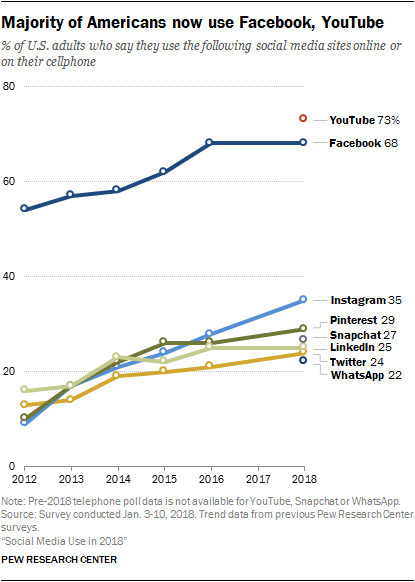
Social media will become, if it hasn’t, an integral part of our daily life. We rely on social media for the latest news update, research before making a purchase, entertainment (funny cat videos), learning new skills, and much more.
As a society, we are addicted to social media. We can’t live without checking out feed at least once every few minutes (unless you’re sleeping).
Don’t believe me? When was the last time you checked your Facebook or Instagram feed? I just checked mine thirty seconds ago!
Hi, my name is Derek Chew and I’m addicted to social media.
Your customers will turn to social media to find reviews and read / see what other people are saying about your services or products even before Google these days.
Your brand’s reputation is on the line now more than ever. And a neglected social media strategy can be costly and detrimental to your business.
I won’t hold anything back here. I’ll explain what to do, where go find it, and how to roll a social media strategy plan out for your business.
Ready? Let’s dive in.
The core components of a good social media marketing plan
Every successful marketing strategy consists of key components that complement one another. Social media is no exception.
Arguably, social media will become the most important marketing strategy for all target markets.
And if it’s not the pillar channel, social media marketing will always be a major contributor to your businesses overall marketing plan.
Whether you’re just about to start your first social media campaign or you’ve been at it for years, there’s always more you can learn or get a refresher on.
Key elements in your social media marketing strategy so it works from day one.
#0: Start with your Why (Purpose and Vision)
You probably were not expecting a step #0. But we are starting here.
Most people will tell you to start with step #1, identifying your goals or creating content right away. Goal setting is important, we’ll get there right after this. Without content there’s nothing to post.
But getting to know your why is of utmost importance.
Figuring out step #0 will help you find greater fulfillment in what your brand, your team, and you do.
It’s what Simon Sinek calls The Golden Circle.
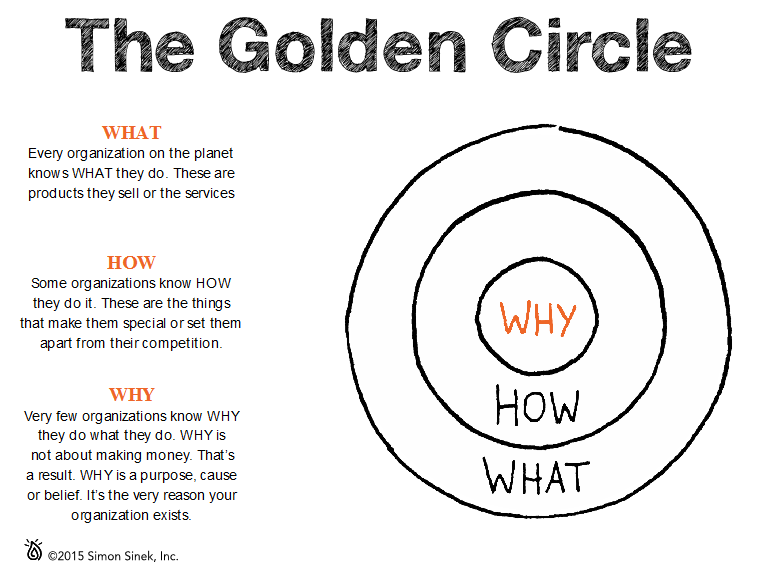
There are three main components to defining your goals. The world teaches us to start with What, How, Why.
Instead of working from the outside in, Sinek starts from the inside out — starting with your WHY, HOW, then WHAT.
Your WHY is the purpose, cause or belief that inspires you.
Knowing your WHY gives you a filter to make choices, at work and at home, that will help you find greater fulfillment in all that you do.
–Simon Sinek
REI found their WHY in 2015, almost eight decades after the company was founded. #OptOutside was one of the most successful social goodness campaign to date.
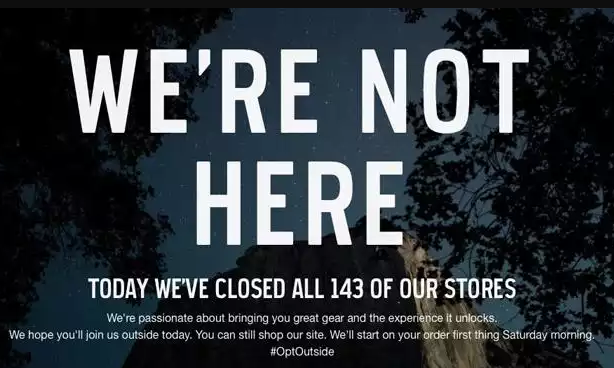
When you find your brand’s WHY, you’ll find clarity in your company goal and become a force to be reckoned with — because instead of selling products or services, you become a purpose-driven brand that impact lives.
#1: Identify your goals
Every aspect of your social media strategy should contribute towards your company goals. You must decide how you can use social media to contribute to them.
As we mentioned above, setting your goals will be influenced by your WHY.
I have seen clients set too many goals and end up achieving none. They were chasing the wrong things.
It’s expected to be ambitious, but it’s more important to be realistic when running a team with limited resources — getting pulled in multiple directions by senior management.
Setting too many goals will have an adverse effect on your strategy.
As a company, your social media strategy should support increasing brand awareness, retaining customers and reducing marketing costs of acquiring new customers.
#2: Setting up your business objectives
Marketing objectives is a road map of how you get from Point A (a vision) to Point B (a fulfilled goal).
We recommend a simple approach called S.M.A.R.T. This structured approach to setting objectives helps you focus your social media strategy on the right things.

The long-term goals of your company can be supported with the SMART approach to make things more structured and achievable.
For instance, as a business, you tasks your social manager to increase brand awareness in social media. That’s great, it doesn’t give any guidance to your team to measure success. Is 2 percent increase considered success? Or are you expected 80 percent?

When you apply the SMART approach, your strategy will be more structured.
Here’s an example of one we did with a client. The brand’s goal was to build brand awareness in social media. And their target audience was primarily Facebook users.
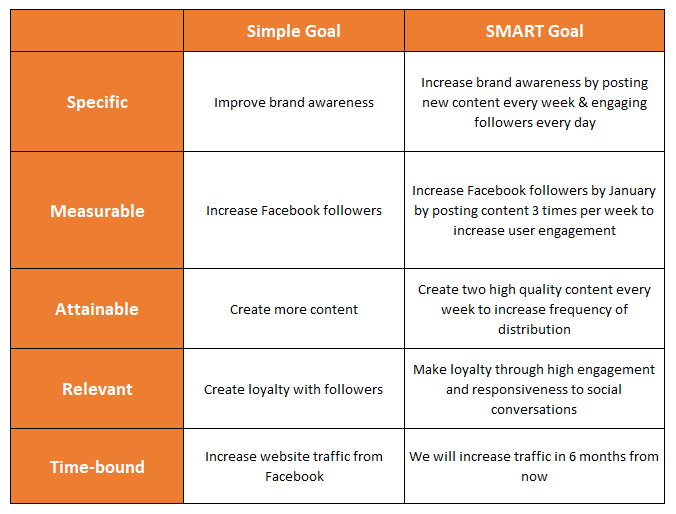
The “Simple Goal” was what they client filled out in our intake questionnaire. The “SMART Goal” is what Fullmoon Digital developed for the client.
The SMART Goal is more detailed. It sets the stage for your why, what and how of the business’ objective.
It is imperative that your social media team does not operate in a vacuum.
Why? You want to avoid teams going off in different directions and hoping that somehow, magically, everyone will achieve the same objective without cohesiveness.
Your objective may be specific, measurable, achievable and relevant, you must set a deadline for achieving the goal. Otherwise your efforts, resources and attention will be pulled in other directions.
#3: Development your audience personas
Personas, avatars, archetypes — are popular names for defining who you are core customers are.
This is where you create “profiles” of who your ideal customer is.
Whether you’re create an email campaign, SEO strategy, or social media marketing plan, knowing as much as you can about your audience is vital to your success.
This part of the process will take some time. But don’t get obsessed and stuck in this step.
Don’t stress over capturing every behavior or desire. You’ll never get the perfect personas. You are looking for excellence, not perfection.
This is a personal with built for a client. It’s nothing fancy; all it needs is to capture the essence of the persona of the audience they were going to target.
![]()
For most brands, three to four personas is all you need to build. The more specific you are, the better results you’re going to get for your business.
Once your team is satisfied with the personas, you create the most relevant and on-point advertising message, offer, and content that will get you the highest reach and engagement.
Pro tip: You can use this persona when creating your content or building your ad copy and assets.
When researching personas for your business, you need to answer these questions:
- What content do they read?
- What motivates them?
- Identify problems they’re trying to solve?
- Their interests (magazines, movies, music, hobbies, etc.)?
- What brands do are they loyal to?
- What events do they attend?
- Do they go on vacations?
…and so on. I’m sure you’ll come up with more questions as you build your personas.
#4: Choosing the right platform / channel
It’s rare for clients to tell me they only want to focus their efforts on one social network. Quite the opposite actually.
When I talk to new clients, they envision their brand on multiple social platforms from Facebook, Instagram, Twitter, to LinkedIn. That’s probable, but seldom reasonable or realistic.
Why? There’s simply not enough resource to pull it off and do it properly. Plus it’s more strategic to focus on the platform where your customers are.
What you want is to identify the social platform where majority of your audience spend time so you generate the most return on your efforts.
If your prospects or customers tell you they spend 60% of their online time on Facebook and 40% on Twitter, you know which primary and secondary social networks you should focus on.
You might read articles that LinkedIn is the best network for B2B leads, or Facebook is the best for B2C brands. This is a myth, just like the other 86 myths of digital marketing.
The truth is — they’re both right and wrong.
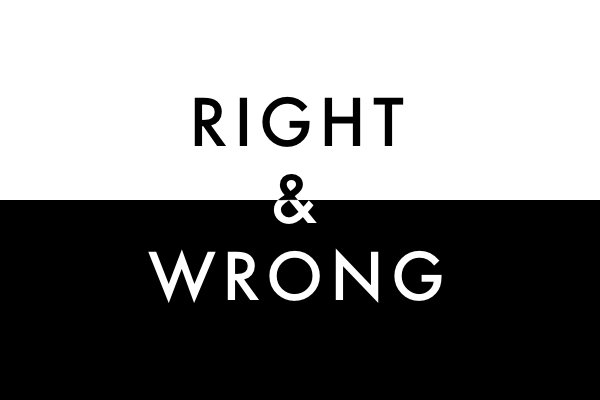
Here’s a performance report of one of our clients. When we started working them, they did not think Facebook would be a great channel to drive sales.
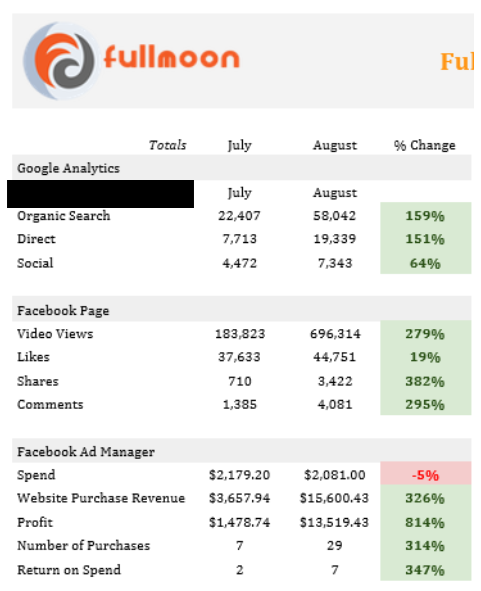
Because their competition were focusing in Google Ads — the client wanted us to launch campaigns in Google to compete.
So we started asking the brand’s “WHY” and build personas. I can’t reveal the details of the research, but after our head of social marketing completed his research, data told us a completely different story.
Facebook was a gold mine for our client
Armed with this valuable information, we started planning out our social media marketing strategy — and our target channel was Facebook.
I added the performance report to illustrate one thing.
Our team scaled Facebook ads from 2X to 7X return on ad spend (ROAS) by understand who to target, where to reach customers, and when to show our ads.
Don’t assume which channel is right or wrong for your brand until you have done your due diligence and gathered data from research. It’s worth the time.
#5: Develop your content strategy so it aligns with your business goal
Content and social media thrive together. You can’t have one without the other — relevant content is required to fuel the growth of social media, and social media is the perfect distribution vehicle for your content.
Some say video is the next big thing, if it’s not already. Five years ago, blogs was all the rage. And years from now, another content type will kick video to the curb — can somebody say VR?
Regardless of what format your content is in, you need to decide on these four pillars of your social marketing strategy:
- are you creating video, articles, images, podcasts, slideshows, etc.
- do you funny, serious, controversial, education, etc.
- how many times will you post content per day/week/month
- what is your distribution strategy (influencers, friends, family, social profiles, etc)
Don’t automatically follow articles or studies that recommend the best time to post on social media. Your business is unique, your customers have their own habits.
Test and figure out what works for your brand. The mistake many people make is to blindly follow what the studies or whitepapers recommend just because it was posted by a social media software company or a social media expert.
Here’s the singular truth about social media marketing.
Nobody knows everything!
#6: Creating your content
While your content strategy outlines the plan of attack, creating the content requires its own planning.
Why? Because once you have figured out the content type, voice and tone, and frequency, you need to put everything together into the actual pieces of content.
Creating content across social networks has similar core components. According to coach and speaker Thomas M. Miller,
Create a compelling story on LinkedIn is to tell a story that solves a very big and real problem that you know that your clients are facing. If you can talk about how you faced that problem and use yourself in a vulnerable manner including discussing your failures your clients will identify with you. Your story should provide a clear road map forward and how not to fall into the same obstacles that you experienced and the client should gain uplift from your story.
There is no hard and fast rule of how to create your content. Over time, you will develop your own approach, voice and style to creating yours.
I won’t leave you hanging though. This is the process I use. You can use this as your template to create your content.
But feel free to add/subtract steps from and make it your own. This approach is by no means the bible — you shouldn’t feel the need to follow it to the tee.
4 steps to creating epic content:
Step 1: Figure out what my readers are searching for
In this case, “social media marketing strategy” is what I decided to focus my article on. Because of the importance of social media to businesses of all sizes, this was a no brainer.
Step 2: Evaluate the impact of my target topic
You can use keyword tools like SEMRush.com and AHrefs.com. I used Ahrefs.com for this research. I clicked over to the Keyword Explorer feature and typed in “social media marketing strategy” in the search box.
This is what the data looks like. There’s a lot going on here, but for the purpose of this article, I will focus on the specific section highlighted in red.
Clicking on the search phrase, I get more details. And the next step is where I start to build out the skeleton for my article.
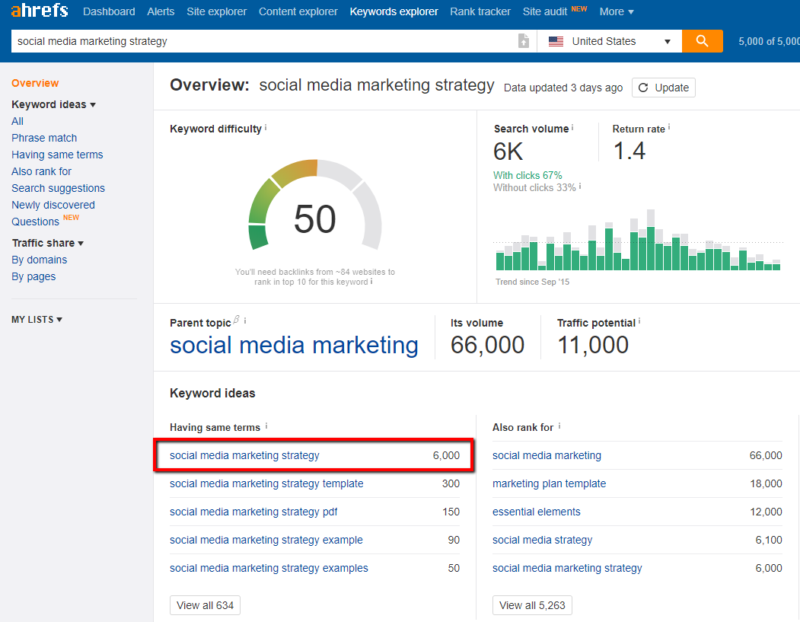
I click on the “View all 634.” This will be different for you depending on your search query.
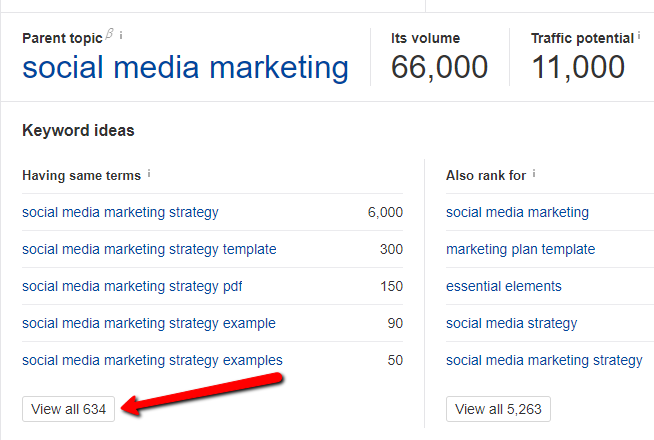
I exported all the keywords into excel and looked at the top 15 to 20 keywords. Those are the keywords that will form the foundation of my article.
Since this article is focused on social media marketing strategies and planning, I ignored keywords that were not relevant like jobs, salary, and about tai lopez.

This is valuable DATA! Now we’re cooking!
Step 3: Build my article outline on the keywords I am targeting
This is something I’m doing more now. I find out beneficial especially when planning a massive article like this one.
But I digress.
My article outline approach that I use derives from Neil Patel’s article. His approach outlines a 45-minute blog writing process, but that won’t work for a hefty article like this one.
But the principle is consistent.
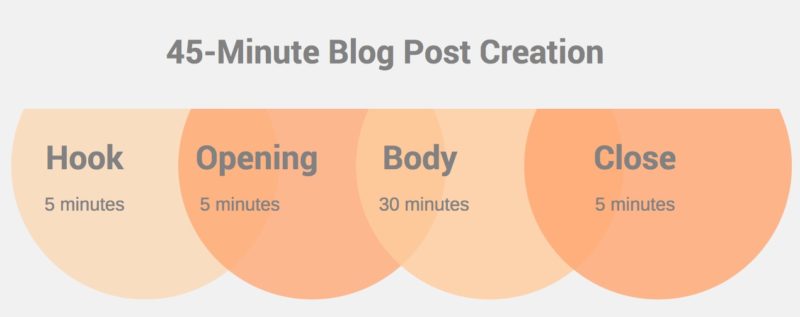
I still have a hook, opening section, a meaty body, and an ultra close. The difference is there’s more details in each section.
I don’t believe in reinventing the wheel when a good one exist.
Pro tip: Don’t forget to create a killer title for the article
Step 4: Write the article
This was definitely not a 45-minute blog article that you might have read about.
Using the outline I created personas, having a solid outline structure in place from the keyword research, it’s time to create.
Here are a few quick tips that I consider when writing this article:
- Don’t be afraid to link out to high profile websites. It will not hurt your site SEO. This is one of the many myths of digital marketing that has you’ll hear people talk about.
- Use relevant images to ease the reader’s.
- Don’t be afraid to use keywords from your research throughout your article. You’re not spamming or keyword stuffing if you’re using your keywords judiciously within context.
- Add quotes from industry thought-leaders, bloggers, influencers, content creators, etc.
- Take as long as you need. Don’t rush through creating your content for the sake of publishing.
It’s also a good idea to include a short bio at the end of the article.
When you create an article, you’re not simply posting great information.
You’re also putting yourself out there as a founder, industry thought-leader, an influencer in the industry.
By including information about yourself, you’re laying the foundation for even greater momentum from the article.

This should turn out to be a great piece of content.
#7: Create a compelling story
Content is where I expect much of the real money will be made on the Internet. – Bill Gates
Many businesses start writing content right away. Hopefully, this article made you realize there are a few vital steps to take before creating and distributing your content.
Whether you are creating videos, blog posts, eBooks, infographics, images, or podcasts, you need to make sure there’s a compelling story worth sharing.
Armed with information about your audience, what keywords they are searching for, and what social platform to focus on, your content should come nicely together at this point.
Content is what fuels social media, so it’s in your best interest to create high quality, engaging, and relevant content.
Pro tip: I strongly recommend you create a content calendar that outlines the schedule of your posts. We’ll get to the content calendar further down. If you want to jump there now, click here.
When I talk to a brand’s content and social team, one of the biggest challenge is defining what “compelling” mean for their brand. It is, however, subjective. Right?
Au contraire.
According to Michelle Pena, from businessmanagementdaily.com, she suggest that content creators do this.
Draw from personal experiences to captivate your audience, help them connect more deeply to your message, and create a lasting impression. You’ll certainly have some really funny stories to share, but others will involve tapping into painful memories or revealing your weaknesses. Go with it. Not only are those parts of you real, but also they are often beautiful. In those moments, abandon self-consciousness. Place your focus on inspiring others, many of whom also juggle their fair share of struggles. Envision every detail you share as a compassionate step toward confidence and resilience. Incredibly, during this very personal trip down memory lane, you will become even more than a storyteller—you are a friend.
Creating a compelling story starts with your brand’s WHY. We talked about this in step #0.
Your purpose breathes life into your content. It might sound like I’m trying to sprinkle some content-magic-fairy-dust on you, but it’s true.
When you create the right content — you will feel it.
There are many suggestion on the internet on how to create a compelling story.
And if you’re unable to channel your inner-Hemingway, follow this basic structure to get started.
Make sure your content includes:
- the reason (your WHY),
- the plight or problem,
- the setting, the solution, and
- tips for your reader to follow.
#8: Have a healthy advertising budget
There are two ways to distribute and promote your epic content — organic or paid social advertising.
Summary: Publish your content. This is just the first step, your work is not done.
Once you hit “publish,” it’s time to reach as many people as you can to share your content.
Naturally, you will post your content on all your social pages; Facebook, Twitter, LinkedIn, Reddit, etc. This will put your content in front of your network, connections and followers.

But don’t stop there. Let’s talk about boosting your content.
Boosting your content in social networks allow for broader and deeper reach — putting your content in front of new audiences beyond your current followers.
Let’s take Facebook for example; since that’s the largest social network to buy ads on.
One of the best features I love about Facebook ads is the ability for me to create audience segments I want to show my ads to.
You can filter your audience by location, age, interest, behaviors, and more. Additionally, you can choose to exclude people you don’t your ads visible to as well.
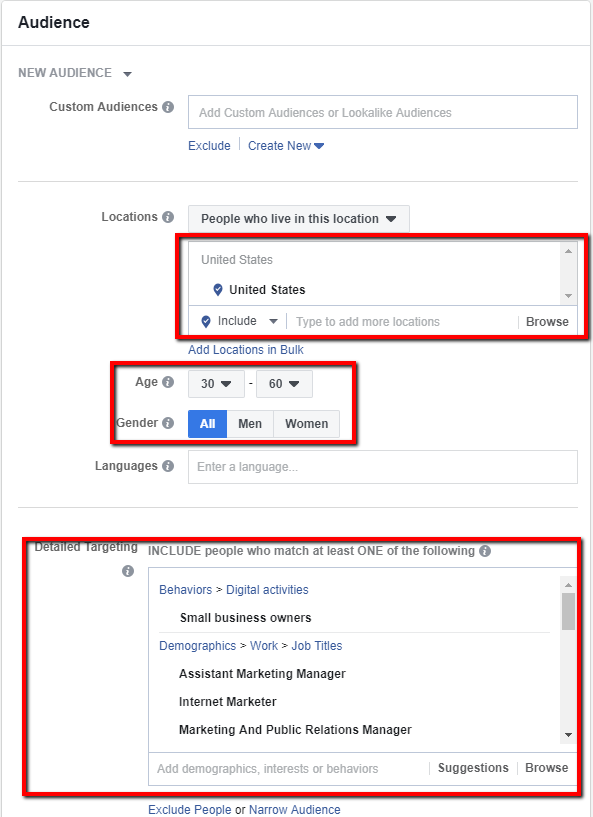
The flexibility and control Facebook Ads gives you as the advertiser is unprecedented. There’s a goldmine of behavior data made available through Facebook’s ad manager tool.
How many people your content reach and engage with is only limited by your creativity.
How much money should you spend on social advertising?
This varies for every advertiser. Your business is unique and your audience is different than other businesses’.
Clients tell me when we talk about advertising budget is “I don’t have $10,000 to spend on Facebook ads.” The perception that you need a big budget to have an effective social advertising campaign is a myth.
Yes, it’s true that your ads will be limited to how many people it reaches. But with the right targeting and audience, you will reach people who are most interested in your content. And that is exactly what you need to focus on.
A smaller audience is not necessarily a bad thing. It’s better to get 20 people clicking to your website out of 500 people who are super interested, than showing your ad to 5,000 unsegmented people without anyone clicking to your website. This is an extreme example, but I cannot stress enough the importance of relevancy and targeting.
Here’s the secret to Facebook advertising.
You can advertise for as little as $2 per day.
We recommend starting with a small budget of about $2 to $5 per day. If you’re audience is built correctly, this small initial budget can get you some interesting data that you can analyze and scale your campaign.
Ad scheduling is another Facebook Ads feature that’s important for you to know.
Why? It allows you to schedule your campaign and “set it and forget it,” so to speak. That just means that Facebook allows you to decide WHO you want to show you ads to and WHEN you want to show your.
That’s powerful!

Here are a few examples where using ad scheduling is helpful. Situations when you schedule your ads with a start and end date:
- When you don’t have a big advertising budget
- When you are running a limited-time promotion
- Show your ads during hours or days you want
- When you want to begin testing different ads at different hours/days
- When your campaign requires you to answer calls
The applications of ad scheduling feature is vast. Using this feature is unique to every business. You need to figure out the best times and days to run your ads, test it, and than iterate and improve.
Writing your killer ad copy
Having an advertising budget and knowing when to run your ads won’t matter
Remember the personas you develop in #3, now is the time to put leverage that information.
We use a simple but effective approach to copy development. It’s a very straightforward grid of hooks against personas.
You can call this whatever you want – but for this article, I will refer to it as our ad grid.

The hook is a vital component of your ad copy. It’s your marketing message that catches the attention of your audience.
Your hook is the WHY that makes people interested in your HOW and WHAT of your products and services.
Writing killer ad copy that is personalized to your audience makes the difference between ads that get clicks versus ads that get A LOT of relevant clicks.
Yes, it’s nuanced, but why create generic ads that appeal to everyone when you can craft ad copy that resonates and connects with your audience on a one-to-one level.
Killer ad copy is all about personalization, or the perception of it.
The example below is ad copy we wrote for one of our clients. They are a B2B company looking to drive more qualified leads to their business.
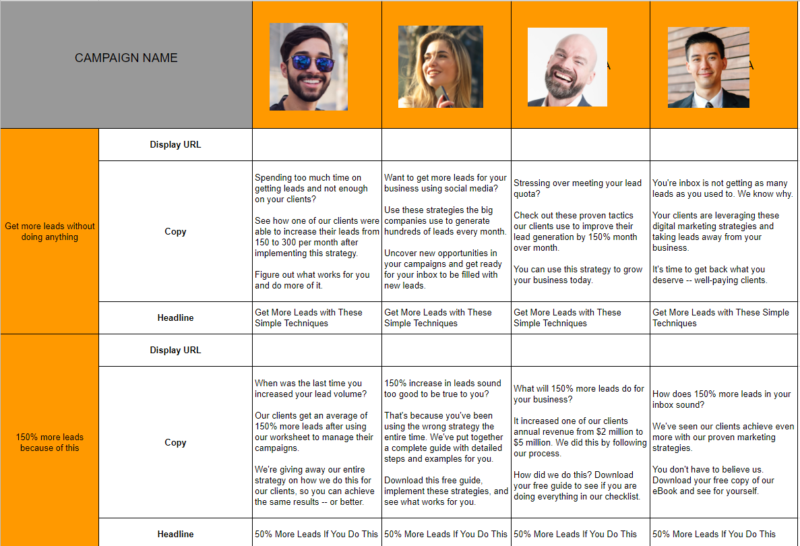
The hooks serve as the foundation of the headline and ad copy.
You can use this template as your guide when creating your advertising message for social ads. Once you have this ad copy developed, you can also use elements of this in other advertising search networks like Google and Bing.
Matching your persona to the right ad copy will increase your chances of being successful.
Pro tip: To keep your ad campaign performing optimally, pay attention to your CTR, design fresh ads, and modify your value proposition.
That’s why research is key as your personas become your targeting foundation.
#9: Assign roles to improve productivity
(not always practical for small business)
If you are doing everything yourself, then this will not apply to you.
For businesses with team members, it is beneficial to have a role and responsibility roster. This makes project management more productive and avoids mix signals and prevents overlapping efforts.
Tools like Basecamp, Trello, and Weekdone are great example of tools you can use to manage your team, assign tasks and collaborate across any project.
Below is an example of the Schedule feature from Basecamp we are using for a few of our clients.

Running a successful social media marketing campaign is time-consuming because of all the moving parts.
It requires collaboration from different teams — from creative and engineering to marketing and sales. What I love about productivity tools is it’s ability to track accountability for each member on the project.
There is a learning curve for each of these tools. So before you can gain efficiency from these tools, be prepared to spend a few hours or days learning how to make the best use of them for your business.
#10: Content calendar
A content calendar or social marketing calendar is basically your planning tool.
How often you will post to each network, which topics you will share and when you will share them.
Your social content calendar includes both organic and paid social content posts.
This document serves as a communication tool for post content (images, articles, and video), post copy, hashtags, and tags to be used for each post. This is extremely important because it allows you to plan and make sure that you’re sending the right message, to the right audience, at the right time.
A well-maintained social media content calendar keeps all your marketing efforts focused on the same business goal. In doing so, you’re can strategically implement and execute your overall marketing strategy.
Along with analytics, which I will discuss later on, this calendar allows you to analyze data across all social media platforms for better understanding of what is working and what’s not.
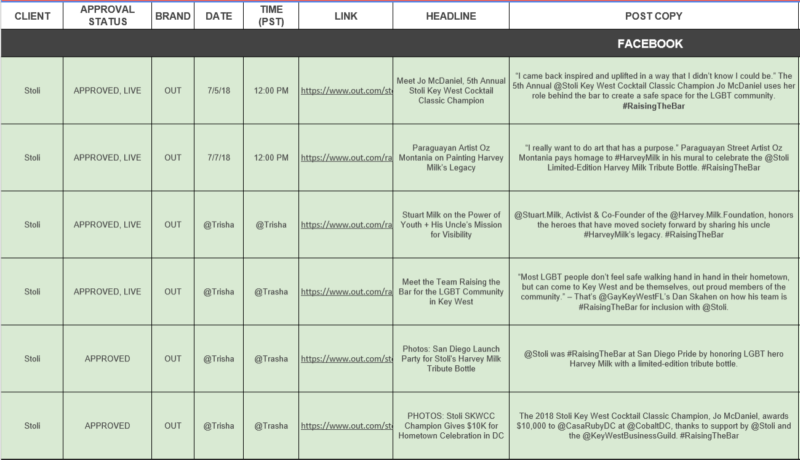
Pro tip: Your calendar doesn’t have to look pretty, and it’ll never be perfect. We use Google Sheets to create our calendar making it easier to share this information across teams and clients.
Once you have your calendar built out, you have the choice of using a social media tools like Hootsuite or SproutSocial.com to schedule, monitor, boost, and manage your content under one roof.
Below is a screenshot of Fullmoon Digital’s scheduled posts using Hootsuite for one week in advance.

In summary, your content calendar is clearly needed so you can do these things:
- Allows you to plan for special holidays & avoid missing important dates.
- Avoid overloading your creative and content team with last minute requests.
- Planning for slower months and peak seasons.
- A repository of content you can re-purpose and expand on
Start developing your social calendar. And make changes as you craft your own posts schedules, promotional campaign, and marketing messages.
#11: Engaging with your audience, don’t ignore them
Social media sites are designed for networking and discovery. That means their main purpose is to share content, discuss topics, and engage.
Your brand must be mindful of these core social network elements to ensure engagement opportunities are not neglected.
As a brand, your social media engagement builds your authority and respect from your audience.
T-Mobile demonstrated a perfect example of how to use social media to listen and help its customers.
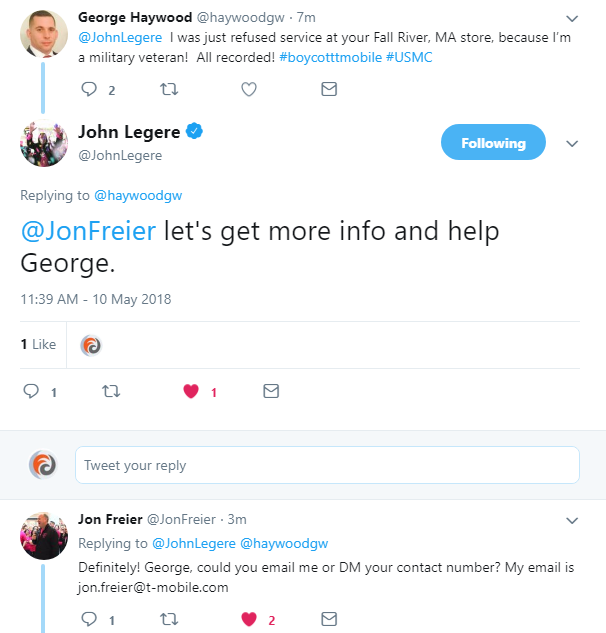
T-Mobile does a wonderful job by showing how much they care about its customers.
Their CEO and VPs have a high level of engagement on social and realized the power of social customer care.
You could say that T-Mobile found their WHY. And it’s integrated into their social strategy. T-Mobile’s social posts are focused on their WHY — they’ve identified the problem and promising change and impact to its existing customers and future customers.

This tweet contains so many key elements that demonstrate how well they understand their audience.
Let’s break it down.
First, the tweet acknowledge that customer service is BROKEN. Customers know this, but what T-Mobile did was admitting it up front. Why?
Because they’re promising to fix the problem. And finally, they refer to their customers as rock stars.
Using the right social monitoring tools, you can find opportunities to interact and respond to customer inquiries, concerns, questions, and conversations.
#12: Social listening and analytics to track your efforts to improve
Whew, we’re almost to the finish line.
Still hanging in there? Great. This is a super important if you are serious about scaling your social media strategy.
Now that you have your personas built, your ad copy created, your content calendar put together, and your campaign launched — all will be in vain if you do not have analytics set up properly.
Your campaign performance data is the key to unlock opportunities and see what’s working.
There are two ways you can monitor social analytics — 1) using the social platform’s native analytics, 2) using a SaaS social analytics tool.
We’ll talk about both briefly below.
Facebook’s navite ads manager analytics
Below is a screenshot of one of our clients. This is reported directly in our Facebook Ads Manager account.
In your Facebook Ads Manager, click on Ads Manager (yes, it’s redundant) – I’m just the messenger.
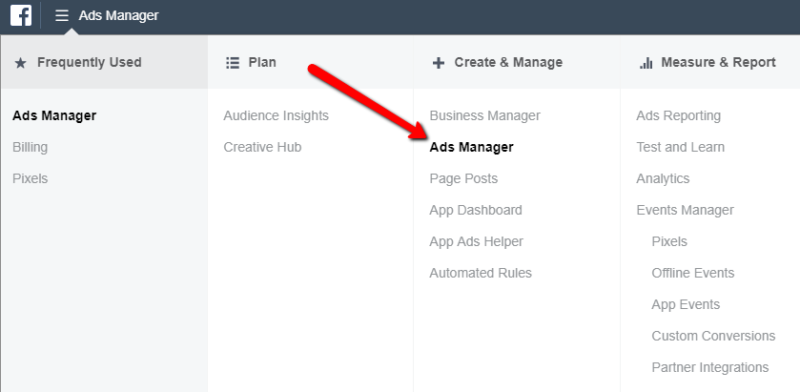
You’ll see a screen similar to what I have below.
There’s a lot more data points like unique clicks, cost per engagement, click-through-rates, etc. But this gives you an idea of the depth of data Facebook collects that you have access to.
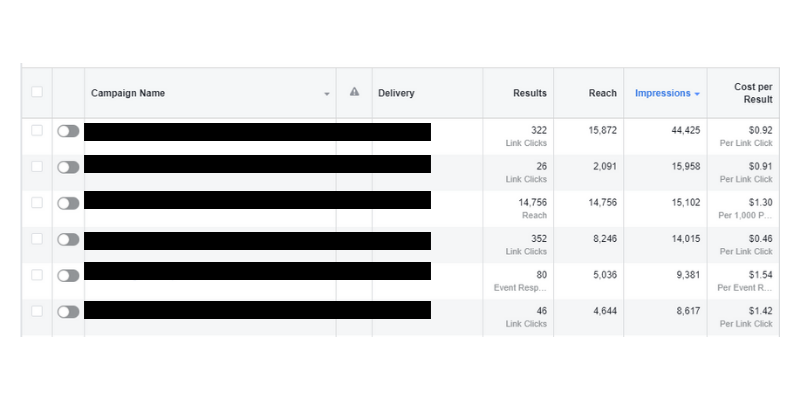
There’s also an entire list of metrics and campaign engagement data you can use to analyze your campaigns.
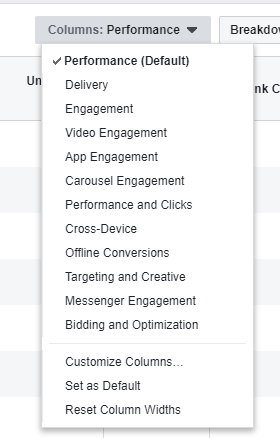
Social analytics software
There are many social analytics tools you can use to track the metric that is important to you. These reports can be automated as well so you receive daily/weekly/monthly updates.
SproutSocial is one of my personal favorite because of its simplicity to measure performance across Facebook, Twitter, Instagram and LinkedIn, all within a single platform.
Consolidating all of your analytics in one place makes it easier to track and compare your efforts across multiple profiles and platforms.

SproutSocial.com has a great article covering the top social analytics tools out there.
If you don’t like flying blind, which I’m sure nobody does — then you must consistently review your social analytics performance.
The wealth of information in your social analytics and listening tool can be dissected and analyzed to give you a deeper understanding and perspective of your website visitors, your ad performance, and insights into engagement metrics.
There are so many metrics to look at. How do you know what to focus on?
The top 5 metrics you should that are worth tracking.
- Your conversion rates
- Frequency – total number of times an ad has been served to an average user.
- Ad spend and ROAS (Return on Ad Spend)
- Cost per Click (CPC) and Click Through Rate (CTR) – general indicator of the appeal of your campaigns.
- Cost per Action – a desirable behavior that you expect from your prospect.
Pro tip: Isolating a metric will not make sense. But, when you view them together, you’ll get good and actionable insight into the performance of your ads.
I know these metrics aren’t the only ones that matter. This article didn’t present an exhaustive list.
But, most marketers take the easy route. They measure and report on vanity metrics that boost their egos and impress their bosses. You don’t need to join that circus.
Conclusion
The importance of social media marketing cannot be ignored.
Anyone with a smartphone will most likely spend time on Facebook, Instagram, Twitter or Snapchat. And that’s the people you want your brand to be in front of.
If you’re not leveraging social media and have not created a content strategy — you have a lot of catching up to do. But it’s never too late to start.
Hopefully this article has given you the information and guidance you need to create your social media marketing strategy.
Bonus!!!
Frequently Asked Questions about Social Media Marketing
What is social media marketing?
Social media marketing involves marketing or advertising on social media sites, such as Facebook, Twitter, LinkedIn, Pinterest and Instagram. Social media marketing revolves around creating high engaging and relevant content in order to build awareness for your brand.
What is the benefits of social advertising?
- Increased brand awareness
- More inbound traffic to your website
- Improved brand loyalty
- Increase brand authority in your industry
- Still a cheaper way to advertise compared to Google Ads
- Improve customer satisfaction
- Have a better pulse on the industry
What are the best social media analytics tools?
- Sprout Social
- Snaplytics
- Iconosquare
- Buzzsumo
- Tailwind
- Google Analytics
- ShortStack
- TapInfluence
What is the best way to handle social media marketing mishaps?
Embrace it.
No matter how good anyone tells you they are in social media marketing, we’re all humans. So mistakes are unavoidable. In the face-paced world of social media, rather that ignoring or deleting hiccups, find an angle of opportunity.


